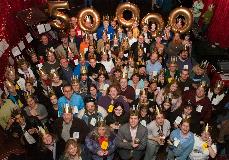Contest challenges participants to write 50,000 words in one month

November 1, 2006
Imagine trying to write a 50,000-plus word novel in one month. That would come to roughly 1,700 words or about five or six pages daily, which might not seem so bad until work, school, family and social life are equated into the picture. Still sound reasonable?
For the National Novel Writing Month organization, better known as NaNoWriMo, it’s nothing short of a good challenge.
Created in San Francisco in 1999, NaNoWriMo is an outlet for writing connoisseurs and fans alike to get the opportunity to write a novel, meet new people and have fun. Starting Nov. 1, the organization encourages its writers to be as creative and imaginative as possible while trying to complete a 50,000 word fiction novel by midnight on Nov. 30.
With participants in 257 U.S. cities and 31 countries, Champaign-Urbana has its own chapter of eager and ambitious writers to boast, led by Municipal Liaisons Beth Anderson and Amy Stevenson, local volunteers who help organize NaNoWriMo groups.
“One of the things I really enjoyed when I first started was being in touch with people that were literary-minded,” said Anderson, a third-year participant. “A lot of the people who try it aren’t afraid to do new things.”
Get The Daily Illini in your inbox!
During its last meeting before the competition started, the participants exchanged plot ideas, which were nothing short of imaginative. From creating mythology to science fiction involving chinchillas who implant microchips in peoples’ brains, the creative juices flowed at the discussion table.
Despite being labeled a “contest”, NaNoWriMo is anything but.
The Champaign-Urbana group holds write-ins two to three times a week during the course of the competition. Write-ins are a way for group member having trouble with plot points to seek advice from other members and to help with writer’s block.
“You wouldn’t think it would as useful as it is sharing your ideas with other writers,” said Stevenson, a fifth-year participant and lab technician at the University. “But it is encouraging and a good resource.”
NaNoWriMo also provides resources for struggling writers on its Web site. Common problems include boring main characters, nonsensical plots, falling behind, and real-life interferences. Advice ranges from killing off characters, writing lengthier and wordier scenes, incorporating the writer’s real life into the novel and adding ninjas, an inside joke among participants.
Continuity and consistency of characters tends to be one of the biggest problems writers face. One solution is the use of character sheets that provide details ranging from previous lovers, tattoos and their Chinese Zodiac. Filling the character sheet has helped many participants who have lost track of their characters, which is a problem Stevenson has run into before.
“In my first novel, I had a character change sex, from a man to a woman,” she said. “It was beyond helping and didn’t make any sense.”
Most writers never really make it to the 50,000 word count, but attempt it anyway. Last year, a record 10,000 writers reached the elusive achievement. Despite the odds against them, many writers attempt to achieve their goal with enthusiasm.
“My first year I made it to only 10,000 words,” said Lindsay Cline, senior in LAS and third-year participant. “I think this year is going to be the year.”
Even though the prizes for the competition may not be all that glamorous (think pens and free icons courtesy of the Web site), NaNoWriMo goes far beyond material prizes.
“People always say that one day they are going to write a novel, but nobody every really gets around to it,” Anderson said. “It’s really just a way to get people to think more creatively and do something they wouldn’t normally do.”
For more information on NaNoWriMo and how to join, visit www.nanowrimo.org.






